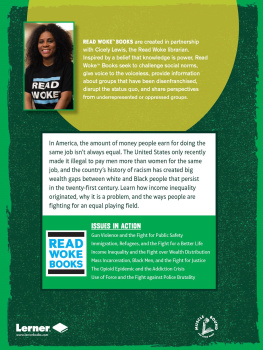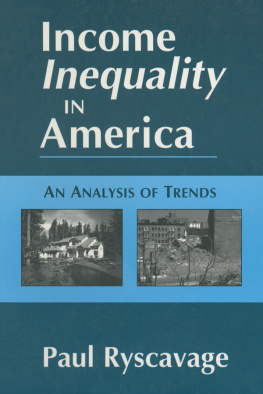First published 2000 by Ashgate Publishing
Reissued 2019 by Routledge
2 Park Square, Milton Park, Abingdon, Oxon, OX14 4RN
52 Vanderbilt Avenue, New York, NY 10017
Routledge is an imprint of the Taylor & Francis Group, an informa business
Copyright Mwangi wa Githinji 2000
All rights reserved. No part of this book may be reprinted or reproduced or utilised in any form or by any electronic, mechanical, or other means, now known or hereafter invented, including photocopying and recording, or in any information storage or retrieval system, without permission in writing from the publishers.
Notice:
Product or corporate names may be trademarks or registered trademarks, and are used only for identification and explanation without intent to infringe.
Publisher's Note
The publisher has gone to great lengths to ensure the quality of this reprint but points out that some imperfections in the original copies may be apparent.
Disclaimer
The publisher has made every effort to trace copyright holders and welcomes correspondence from those they have been unable to contact.
A Library of Congress record exists under LC control number:
ISBN 13: 978-1-138-73987-1 (hbk)
ISBN 13: 978-1-315-18399-2 (ebk)
Kenya was widely viewed as an African success story in the early post-colonial period. Indeed Kenya and Tanzania often were contrasted by the World Bank and those who shared its view of the world. Kenya was liberal and strongly market orientated, that is, broadly capatilist while Tanzania was interventionist and communitarian, that is, broadly socialist. Economic growth was faster in Kenya than in Tanzania and this was taken as evidence of the superiority of capitalism over socialism in Africa and the third world more generally.
Today perceptions are rather different. The criticism of Tanzania has become muted while the praise of Kenya has ceased. In the 1990s average incomes in Kenya have fallen and inequality has become enormous. The World Bank, for instance, publishes data on the distribution of income in 90 countries, of which 20 are in Africa. The Gini coefficient for Kenya is said by the bank to be 57.5. Only two countries in Africa (Sierra Leone and South Africa) have a more unequal distribution of income. The Gini coefficient in Tanzania, in contrast, is reported to be 38.1. Only four countries in Africa (Cote d' Ivoire, Egypt, Niger and Rwanda) have a more equal distribution of income.
It was once thought that the distribution of income in Africa was likely to be more equal than in other developing regions. There were three reasons for this. First, the proportion of the population living in rural areas and engaged in agriculture was believed to be higher in Africa than in Asia and Latin America. Since inequality in rural areas was believed to be less than in urban areas, this structural difference would predispose Africa to a relatively greater degree of equality. In fact, however, the extent of urbanization is not markedly different in sub-Saharan Africa than in South and East Asia, although it is much lower than in Latm America, the Middle East and Central Asia. Moreover, as we shall see, rural inequality can greatly exceed urban inequality.
Second, it was thought that Africa is a relatively land-abundant, labor-scarce economy, certainly as compared to most of Asia. Labor scarcity was expected to result in a relatively high level of real wages and hence in a higher share of wages relative to income from property, i.e., land and physical capital. In fact, population density in sub-Saharan Africa, while much lower than the population densities in South and East Asia, is comparable to that in Latin America, the Middle East and Central Asia. Moreover, quite apart from the level of wages, the growth of real wages in the manufacturing sector has been negative throughout the 1990s in several African countries, not only in Kenya but also, for example, in Zimbabwe and Botswana.
Third, it was widely believed that tenure systems in Africa ensured that rural households had free access to land and hence that inequality arising from an uneven and inequitable distribution of land ownership was not a serious problem. The rural sector of the economy was regarded as rather homogeneous and, in effect, classless. Here, too, however the early generalizations proved to be false. In areas of European settlement (Kenya, Zimbabwe, South Africa) the high degree of land concentration that was characteristic of the colonial period was replicated by the newly independent states. In Kenya, large European landowners were simply replaced by large African landowners. In Zimbabwe and South Africa the structure of ownership was left largely intact, and elsewhere in sub-Saharan Africa, land concentration tended to increase as communal tenure systems weakened and private property rights in land were created for the disproportionate benefit of the powerful and influential.
Thus the stereotypical view of Africa as a region of shared poverty and little inequality is false. The great virtue of this book, Ten Millionaires and Ten Million Beggars, is that it documents and analyses in considerable detail the contemporary reality of one major African country, Kenya, and thereby greatly increases our understanding of the political economy of that country. Indeed Dr. Mwangi makes three important contributions.
First, he provides what is surely the best available estimate of income inequality in Kenya. Second, he presents data on time allocation in Kenya which makes it possible for the first time to compare the distribution of work with the distribution of income. And third, he attempts to construct a class analysis of rural Kenya that goes far beyond the debates of the 1970s and 1980s. I shall comment briefly on each of the contributions.
Dr. Mwangi uses two building blocks to construct an estimate of the distribution of income in 1988, namely, the 1988 Rural Labour Force Survey (with a sample of more than 44,000 individuals) and the 1986 Urban Labour Force Survey (with a sample of more than 9,000 individuals). Only about five percent of the population is excluded from these samples, mostly pastoralists. Thus the sample coverage is good.
Previous studies of income inequality in Kenya there were six of them were based on less reliable data and smaller samples. The Gini coefficients of inequality in these studies fall in a range of 48 to 67. Dr. Mwangi's estimate of the Gini coefficient of per capita household income for Kenya as a whole is 76.3. This is substantially higher than any of the earlier estimates and also higher than the figure published by the World Bank, mentioned previously. If one assumes that Dr. Mwangi's estimate is reliable and also that the World Bank's figures are accurate for the other 89 countries for which estimates are published, then one must conclude that the distribution of income in Kenya is not only the most unequal in Africa, it is the most unequal in the world! Kenya is indeed a land of Ten Millionaries and Ten Million Beggars. According to Dr. Mwangi's calculations the top 10 percent of households receive over 68 percent of total income.








